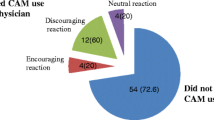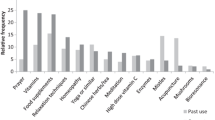Abstract
Purpose
The worldwide use of complementary and alternative medicine (CAM) among cancer patients has increased, with breast cancer patients being more likely to use CAM compared with any other cancer patients. However, few surveys have systematically described CAM use among Korean breast cancer patients. This study investigated the use of CAM among patients who were diagnosed with breast cancer, along with the relevant demographic and clinical factors related to CAM use. We also compared the difference in quality of life between CAM users and nonusers.
Methods
A total of 661 patients were invited to participate in this study during routine clinic visits, with 425 patients ultimately participating. Three hundred ninety-nine questionnaires were completed and used in the final analysis. Quality of life was evaluated based on the Korean versions of the EORTC QLQ-C30 and EORTC QLQ-BR23.
Results
Previous or current CAM usage was reported by 229 patients (57.4%). Independent factors related to CAM use were marital status, cancer stage, and coexisting illness. The common types of CAM use included exercise therapy (43.2%) and ingestion of vitamins and minerals (41.9%). The reasons for CAM use were to boost the immune system (53.2%), promote health (46.8%) and prevent recurrence (37.7%). Large proportions (70.4%) of CAM users did not discuss their CAM use with their physicians. Only a small number of CAM users (2.5%) answered that they were unsatisfied with their CAM use, with most CAM users reporting that they would continue their CAM use. Quality of life was not significantly different between CAM users and nonusers.
Conclusions
A significant number of patients with breast cancer have used CAM, and health care providers should be aware of the variety of CAM methods and their patients’ CAM uses for the proper management of breast cancer.

Similar content being viewed by others
References
Eisenberg DM, Davis RB, Ettner SL et al (1998) Trends in alternative medicine use in the United States, 1990–1997: results of a follow-up national survey. JAMA 280(18):1569–1575
Cassileth BR, Schraub S, Robinson E, Vickers A (2001) Alternative medicine use worldwide: the International Union Against Cancer survey. Cancer 91(7):1390–1393
Lee SI, Khang YH, Lee MS, Koo HJ, Kang WC, Hong CG (1999) Complementary and alternative medicine use in Korea: prevalence, pattern of use, and out-of-pocket expenditures. Korean J Prev Med 32:546–555
Ock SM, Choi JY, Cha YS et al (2009) The use of complementary and alternative medicine in a general population in South Korea: results from a national survey in 2006. J Korean Med Sci 24(1):1–6
Lee KS, Ahn HS, Hwang LI, Lee YS, Koo BH (1998) Utilization of alternative therapies in cancer patients. Cancer Res Treat 30:203–213
Kim MJ, Lee SD, Kim DR et al (2004) Use of complementary and alternative medicine among Korean cancer patients. Korean J Intern Med 19:250–256
Morris KT, Johnson N, Homer L, Walts D (2000) A comparison of complementary therapy use between breast cancer patients and patients with other primary tumor sites. Am J Surg 179(5):407–411
Gray RE, Fitch M, Goel V, Franssen E, Labrecque M (2003) Utilization of complementary/alternative services by women with breast cancer. J Health Soc Policy 16(4):75–84
Ashikaga T, Bosompra K, O’Brien P, Nelson L (2002) Use of complementary and alternative medicine by breast cancer patients: prevalence, patterns and communication with physicians. Support Care Cancer 10:542–548
Boon H, Stewart M, Kennard MA et al (2000) Use of complementary/alternative medicine by breast cancer survivors in Ontario: prevalence and perceptions. J Clin Oncol 18(13):2515–2521
Buettner C, Kroenke CH, Phillips RS, Davis RB, Eisenberg DM, Holmes MD (2006) Correlates of use of different types of complementary and alternative medicine by breast cancer survivors in the nurses’ health study. Breast Cancer Res Treat 100(2):219–227
Nagel G, Hoyer H, Katenkamp D (2004) Use of complementary and alternative medicine by patients with breast cancer: observations from a health-care survey. Support Care Cancer 12(11):789–796
Ernst E, Cassileth BR (1998) The prevalence of complementary/alternative medicine in cancer: a systematic review. Cancer 83(4):777–782
Kristoffersen AE, Fonnebo V, Norheim AJ (2008) Use of complementary and alternative medicine among patients: classification criteria determine level of use. J Altern Complement Med 14(8):911–919
Lee MM, Lin SS, Wrensch MR, Adler SR, Eisenberg D (2000) Alternative therapies used by women with breast cancer in four ethnic populations. J Natl Cancer Inst 92(1):42–47
Cui Y, Shu XO, Gao Y et al (2004) Use of complementary and alternative medicine by chinese women with breast cancer. Breast Cancer Res Treat 85(3):263–270
Shen J, Andersen R, Albert PS et al (2002) Use of complementary/alternative therapies by women with advanced-stage breast cancer. BMC Complement Altern Med 2:8
Henderson JW, Donatelle RJ (2004) Complementary and alternative medicine use by women after completion of allopathic treatment for breast cancer. Altern Ther Health Med 10(1):52–57
Carlsson M, Arman M, Backman M, Flatters U, Hatschek T, Hamrin E (2004) Evaluation of quality of life/life satisfaction in women with breast cancer in complementary and conventional care. Acta Oncol 43(1):27–34
Carpenter CL, Ganz PA, Bernstein L (2009) Complementary and alternative therapies among very long-term breast cancer survivors. Breast Cancer Res Treat 116(2):387–396
Burstein HJ, Gelber S, Guadagnoli E, Weeks JC (1999) Use of alternative medicine by women with early-stage breast cancer. N Engl J Med 340(22):1733–1739
Kronenberg F, Cushman LF, Wade CM, Kalmuss D, Chao MT (2006) Race/ethnicity and women’s use of complementary and alternative medicine in the United States: results of a national survey. Am J Public Health 96(7):1236–1242
Hong CD (2001) Complementary and alternative medicine in Korea: current status and future prospects. J Altern Complement Med 7(Suppl 1):S33–S40
Kim DY, Kim BS, Lee KH et al (2008) Discrepant views of Korean medical oncologists and cancer patients on complementary and alternative medicine. Cancer Res Treat 40(2):87–92
Adler SR, Fosket JR (1999) Disclosing complementary and alternative medicine use in the medical encounter: a qualitative study in women with breast cancer. J Fam Pract 48(6):453–458
Eisenberg DM, Kessler RC, Foster C, Norlock FE, Calkins DR, Delbanco TL (1993) Unconventional medicine in the United States. Prevalence, costs, and patterns of use. N Engl J Med 328(4):246–252
Chung HJ, Kim MR, Bae JS et al (2006) Complementary and alternative medicine in patients with breast cancer. J Breast Cancer 9:361–366
Henderson JW, Donatelle RJ (2003) The relationship between cancer locus of control and complementary and alternative medicine use by women diagnosed with breast cancer. Psychooncology 12(1):59–67
Montazeri A, Sajadian A, Ebrahimi M, Akbari ME (2005) Depression and the use of complementary medicine among breast cancer patients. Support Care Cancer 13(5):339–342
Owens B, Jackson M, Berndt A (2009) Complementary therapy used by Hispanic women during treatment for breast cancer. J Holist Nurs 27(3):167–176
Gansler T, Kaw C, Crammer C, Smith T (2008) A population-based study of prevalence of complementary methods use by cancer survivors: a report from the American Cancer Society’s studies of cancer survivors. Cancer 113(5):1048–1057
Greenlee H, Kwan ML, Ergas IJ et al (2009) Complementary and alternative therapy use before and after breast cancer diagnosis: the Pathways Study. Breast Cancer Res Treat 117(3):653–665
Jordan ML, Delunas LR (2001) Quality of life and patterns of nontraditional therapy use by patients with cancer. Oncol Nurs Forum 28(7):1107–1113
Kappauf H, Leykauf-Ammon D, Bruntsch U et al (2000) Use of and attitudes held towards unconventional medicine by patients in a department of internal medicine/oncology and haematology. Support Care Cancer 8(4):314–322
Paltiel O, Avitzour M, Peretz T et al (2001) Determinants of the use of complementary therapies by patients with cancer. J Clin Oncol 19(9):2439–2448
Boon H, Brown J, Gavin A (2000) What are the experiences of women with breast cancer as they decide whether to use complementary/alternative medicine? West J Med 173(1):39
Sollner W, Maislinger S, DeVries A, Steixner E, Rumpold G, Lukas P (2000) Use of complementary and alternative medicine by cancer patients is not associated with perceived distress or poor compliance with standard treatment but with active coping behavior: a survey. Cancer 89(4):873–880
Pedersen CG, Christensen S, Jensen AB, Zachariae R (2009) Prevalence, socio-demographic and clinical predictors of post-diagnostic utilisation of different types of complementary and alternative medicine (CAM) in a nationwide cohort of Danish women treated for primary breast cancer. Eur J Cancer 45(18):3172–3181
Helyer LK, Chin S, Chui BK et al (2006) The use of complementary and alternative medicines among patients with locally advanced breast cancer—a descriptive study. BMC Cancer 6:39
Chen Z, Gu K, Zheng Y, Zheng W, Lu W, Shu XO (2008) The use of complementary and alternative medicine among Chinese women with breast cancer. J Altern Complement Med 14(8):1049–1055
Yap KP, McCready DR, Fyles A, Manchul L, Trudeau M, Narod S (2004) Use of alternative therapy in postmenopausal breast cancer patients treated with tamoxifen after surgery. Breast J 10(6):481–486
Ashikaga T, Bosompra K, O’Brien P, Nelson L (2002) Use of complimentary and alternative medicine by breast cancer patients: prevalence, patterns and communication with physicians. Support Care Cancer 10(7):542–548
Jacobson JS, Workman SB, Kronenberg F (2000) Research on complementary/alternative medicine for patients with breast cancer: a review of the biomedical literature. J Clin Oncol 18(3):668–683
Girgis A, Adams J, Sibbritt D (2005) The use of complementary and alternative therapies by patients with cancer. Oncol Res 15(5):281–289
Montazeri A, Sajadian A, Ebrahimi M, Haghighat S, Harirchi I (2007) Factors predicting the use of complementary and alternative therapies among cancer patients in Iran. Eur J Cancer Care (Engl) 16(2):144–149
Tasaki K, Maskarinec G, Shumay DM, Tatsumura Y, Kakai H (2002) Communication between physicians and cancer patients about complementary and alternative medicine: exploring patients’ perspectives. Psychooncology 11(3):212–220
Schofield P, Diggens J, Charleson C, Marigliani R, Jefford M (2010) Effectively discussing complementary and alternative medicine in a conventional oncology setting: communication recommendations for clinicians. Patient Educ Couns 79(2):143–151
Acknowledgement
This research was supported by grant no 02-2008-006 from the SNUBH Research Fund.
Conflict of interest
The authors declare that they have no competing interests.
Author information
Authors and Affiliations
Corresponding author
Appendix
Appendix



Rights and permissions
About this article
Cite this article
Kang, E., Yang, E.J., Kim, SM. et al. Complementary and alternative medicine use and assessment of quality of life in Korean breast cancer patients: a descriptive study. Support Care Cancer 20, 461–473 (2012). https://doi.org/10.1007/s00520-011-1094-z
Received:
Accepted:
Published:
Issue Date:
DOI: https://doi.org/10.1007/s00520-011-1094-z




